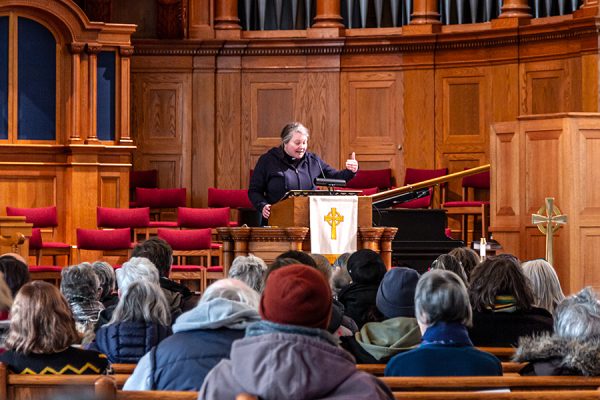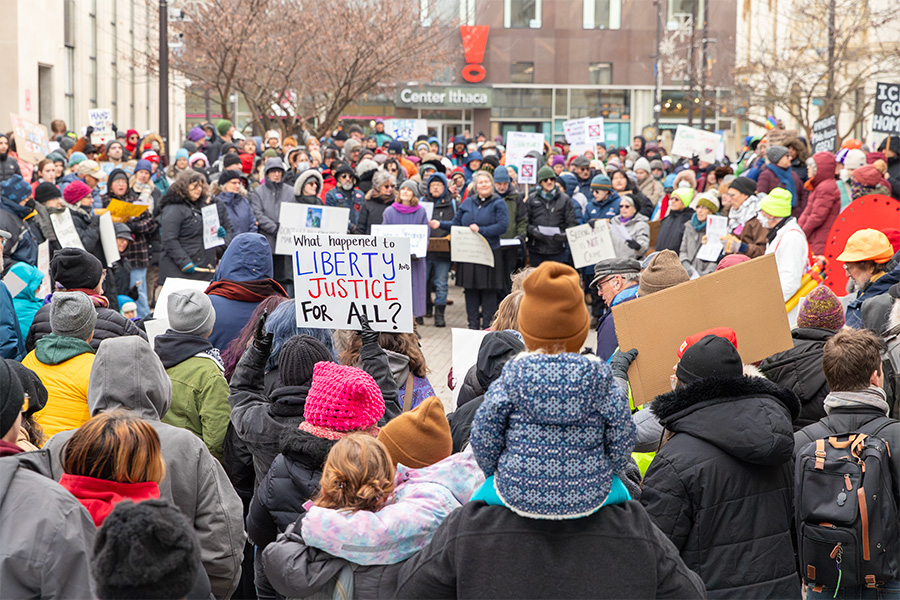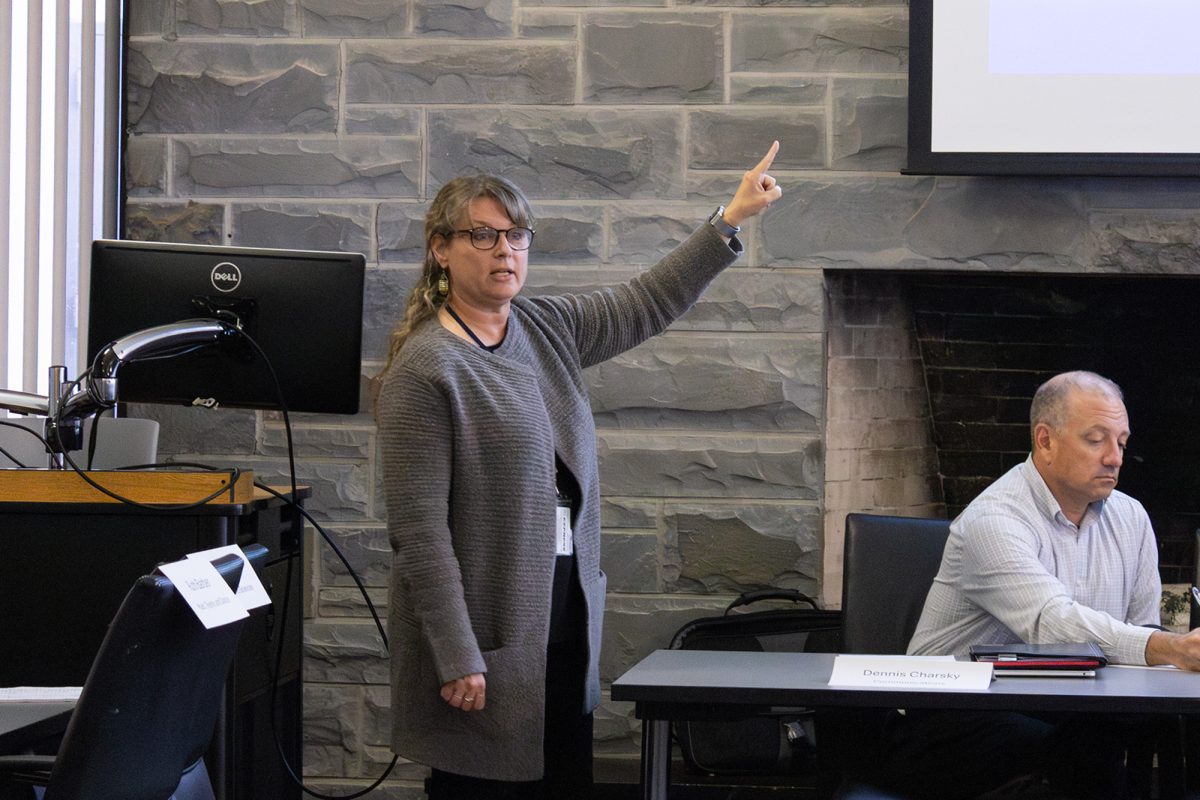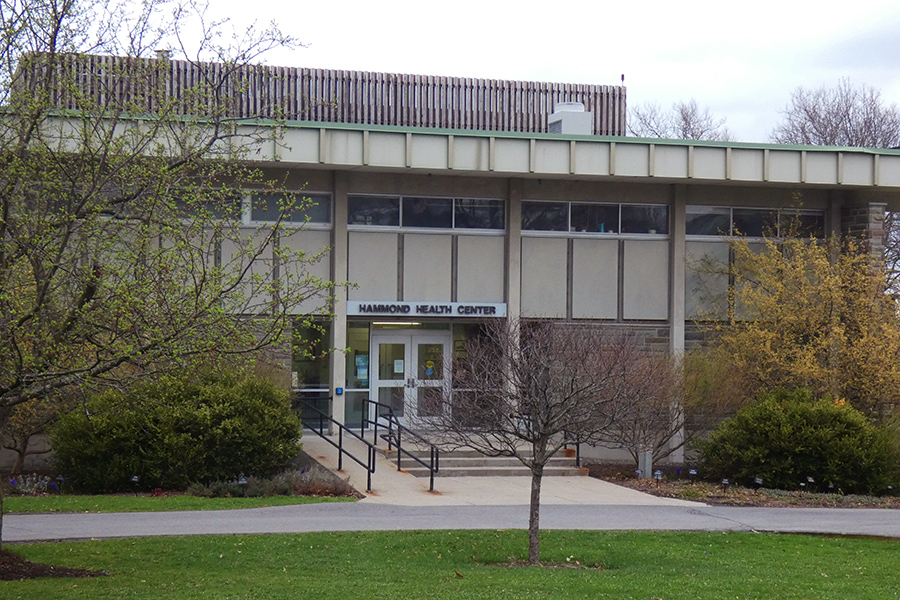On Jan. 30, reporters from the Ithaca Voice and the Ithaca Times shared information about the presence of U.S. Immigration and Customs Enforcement in Ithaca. According to a press release from the Department of Justice, ICE arrested Jesus Romero-Hernandez at Tompkins County Department of Social Services.
Romero-Hernandez, 27, is a Mexican citizen who has been charged with entering the U.S. illegally seven times. Romero-Hernandez was serving time in the Tompkins County jail after being locally convicted of assault in late 2023. On Jan. 8, 2024, Romero-Hernandez was federally charged with illegal reentry into the country — the eighth instance. Romero-Hernandez completed his local assault sentence before the DOJ moved forward with federal prosecution.
Romero-Hernandez completed his time served and was released from local jail Jan. 28, despite a federal warrant and the DOJ calling for the Tompkins County Sheriff’s Department to hold Romero-Hernandez until ICE could detain him. The Tompkins County Sheriff and the Ithaca Police Department — as a sanctuary county and a sanctuary city — did not aid federal immigration authorities in their targeted pursuit of Romero-Hernandez.
County Sheriff Derek Osborne has come under scrutiny from the DOJ for the county law enforcement’s decision not to aid ICE in its pursuit of Romero-Hernandez.
Shannon Alvord, public health communications coordinator at Tompkins County Whole Health Department, released a statement to the media Jan. 30 to dispute the DOJ’s claim that Tompkins County law enforcement disrupted ICE operations:
“The Sheriff and his staff acted consistently with New York state law and judicial decisions, county policy, guidance of the New York Attorney General’s Office and guidance of the New York State Sheriffs’ Association. There was no interference with federal immigration enforcement efforts. Moreover, DOJ’s assertion that the Tompkins County Sheriff did anything to put federal law enforcement officers in danger is false and offensive. The safety of all law enforcement is our top priority. In contrast, Immigration and Customs Enforcement (ICE) knew exactly when the individual in question was going to be released and had every opportunity to come to the Tompkins County jail to obtain the individual in question without any need for a pursuit or other incident.”
What we know about Jesus Romero-Hernandez
Romero-Hernandez appeared in court via Zoom on Jan. 31 to set plans for his next hearing. He was held in Oneida County jail until his set hearing on Feb. 4, when he appeared in federal court in Syracuse. The federal judge determined that he should remain in custody due to four outstanding misdemeanors and a record of resisting arrest.
Romero-Hernandez’s public defender, Gabriela Wolfe, declined a request for comment. Tamara Thomson, public information officer for the U.S. Attorney’s Office in the Northern District of New York, also declined a request for comment.
National context
Ithaca has been a sanctuary city since Feb. 1, 2017. According to the Center for Immigration Studies, there are 16 sanctuary counties in New York state, including Tompkins County, which declared sanctuary status in its Feb. 21, 2017, resolution “Public Safety For All” — 20 days after the city’s declaration. Albany and New York City are also listed as designated sanctuary cities.
There are approximately 600 sanctuary jurisdictions in the U.S., according to the Federation for American Immigration Reform. The exact definition of a sanctuary city is dependent on the individual city’s policy. Ithaca, for example, outlines its policy in its city code. The precedent for sanctuary jurisdictions comes from the 10th Amendment of the U.S. Constitution, which states that the federal government cannot force state or local governments to enforce federal regulations. This makes compliance with federal immigration entities, like ICE, a voluntary act rather than a compulsory one.
President Donald Trump has a history of targeting sanctuary cities. In his first term, he restricted sanctuary cities’ access to federal funding, an order which former President Joe Biden rescinded. Since taking office for his second term, Trump has extended federal immigration enforcement’s scope. The president signed an executive order, “Protecting the American People Against Invasion,” which explicitly addresses sanctuary jurisdictions in Section 17:
“The Attorney General and the Secretary of Homeland Security shall, to the maximum extent possible under law, evaluate and undertake any lawful actions to ensure that so-called ‘sanctuary’ jurisdictions, which seek to interfere with the lawful exercise of Federal law enforcement operations, do not receive access to Federal funds.”
Trump also signed the Laken Riley Act, which expands the power of federal agencies to report and detain undocumented immigrants. Other immigration-related executive orders include denying citizenship to the U.S.-born children of undocumented immigrants and enforcing border protection.
Other sanctuary jurisdictions have felt the effects of recent policy changes. Heightened ICE presence has been reported in sanctuary cities with significant immigrant populations, including Chicago, New York and Los Angeles.

Community Response
On Feb. 2, about 100 Ithaca community members gathered on The Commons to protest ICE’s presence in Ithaca. Gatherers sang songs and chanted along with drums and small instruments.
Joanna Green, a local community organizer, attended the outdoor rally with fellow organizer, Amala Lane. Lane said that, together with Green, she is working on starting a Tompkins County branch of Indivisible, a hyper-local movement to support democracy.
Green said the rally was organized by the First Presbyterian Church of Ithaca in collaboration with other groups like Catholic Charities of Tompkins/Tioga.
“It’s so hard to know what’s going on,” Green said. “We don’t have our [organizational] network set up yet to watch [ICE] very well.”
Ralliers then walked to the church for a forum, where the number of people increased to over 250. The forum included speeches from Senior Pastor Kirianne Weaver, 1st Ward Alderperson Kayla Matos and members of the community.
“It’s really important for us to remember the people that can’t be here today, because they’re not feeling safe to come out to an event like this where you’re putting yourself on the line,” Weaver said.
Weaver said at the forum that the Trump administration’s immigration policies have already started to affect members of the community. She said she has heard of kids not going to playgroups and students not going to school out of fear.
“[Families are] afraid that something’s gonna happen to them on the way,” Weaver said. “They’re afraid somebody’s gonna be waiting outside their school. We are here, in part, because we are trying to dispel that fear that’s been building.”
Matos said at the forum that the city’s Common Council would vote to reaffirm Ithaca’s status as a sanctuary city Feb. 5.
“Ithaca is still going to continue to maintain our status as a sanctuary city, even though we are recognizing that this could put a target on our back,” Matos said. “However, our elected officials are willing to take that fight.”
In an interview with The Ithacan, 4th Ward Alderperson Patrick Kuehl said that the first time he heard of ICE presence in Ithaca was when the public found out via local publications and X.
“We were informed about the presence of ICE in Ithaca, and the Ithaca Police Department, of course, followed all rules and regulations set forth for the city,” Kuehl said. “We’ll do everything … to make sure that people are protected and feel that Ithaca is a welcoming place for all people, regardless of where they’re coming from.”
Casey Verderosa, executive director of Ithaca Welcomes Refugees, said that although she has no legal expertise in sanctuary city laws, she is conscious of the timing of ICE’s presence in Ithaca.
“I wonder, since we are a sanctuary city, if the reason why this person was targeted at this time could have had something to do with the new administration,” Verderosa said.
Verderosa said she is concerned that ICE will not follow the law, citing instances of ICE purposely misleading people.
“I have a concern that [ICE] would maybe sweep people up who are not in these targeted categories of people with a criminal history, that they might just deport people who are good people, who came here on legal programs,” Verderosa said. “It feels like a lot of the newer ICE activity [is] very racially motivated and just out of a fear of people who are foreign and look different.”
For non-citizen members of the Ithaca community who do have documentation, Verderosa recommended that they carry documents with them, whether that’s a green card or a copy of the visa page from their passports.
Verderosa also said Ithaca Welcomes Refugees has arranged for some of its clients on temporary programs to get their asylum claims filed. She said that while the decisions on claims are pending, families can stay in the U.S. legally.
“We’re trying to prepare everybody — from the people we work with to our volunteers and our staff — on how to face ICE,” Verderosa said.
Editor-in-Chief Lorien Tyne and Assistant News Editor Julian DeLucia contributed reporting.

















